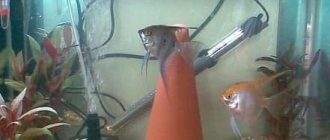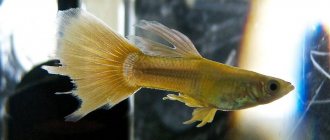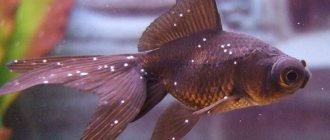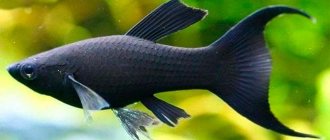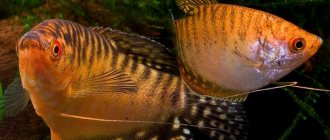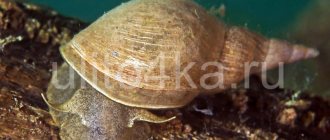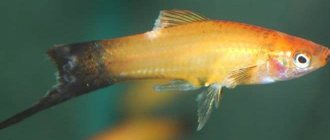DIY hatchery for fry
Why do you need a depositor?
If the fish give birth to fry, then the condition of the aqua is quite satisfactory. Consequently, sooner or later the owner of ornamental fish is faced with the problem of preserving the young. The fact is that tiny fry are excellent food for almost all adults.
If the juveniles are not removed in time, isolating them from the rest of the inhabitants of the aquarium, then they will be eaten in the shortest possible time. Some aquarists place the fry in separate trays or jars.
A special fish tank for fry located directly in the general aquarium can successfully solve the problem of their preservation and subsequent growth. Before spawning, adult fish are placed there, and immediately after the offspring appear, the parents are moved back to the common aqua. Only kids remain in the detention center.
Before you start making a depositor with your own hands, it would be a good idea to familiarize yourself with the existing types of these devices.
Types of sedimentation tanks
The simplest do-it-yourself fish tank for fry
The material for making a quarantine mini-aquarium for juveniles at home can be a simple transparent plastic mineral water bottle. Juice or drink bottles are not suitable: plastic may contain molecules of foreign chemicals.
First you need to remove the label and thoroughly rinse off any remaining glue. The top part of the bottle (about 1/3 of its height) is cut off, but not all the way. It is necessary to leave a piece of plastic approximately 3-5 centimeters wide to make the handle of the future depositor.
The improvised handle must be bent in half, the bend must be heated over a fire, preventing complete melting, and fixed in the form of a kind of hook. The height of the future homemade fish tank and the size of the hook must be selected so that the edges of the plastic house for the fry are above the level of the aquarium water.
For the subsequent operation you need to be patient. A thick needle or thin awl is used to pierce many holes in the plastic of the bottle. Aquarium water will flow through them. Holes should not be made along the entire circumference, but on one side (about ¼ of the surface). There is also no need to pierce the bottle all the way to the bottom: when changing the water, if necessary, the water with the fry will remain in the lower part.
If you make holes from the outside, then inside this container there will be notches like a fine grater. A female that moves sharply from side to side during spawning can be seriously injured. And such a grater can also cause injury to juveniles. But for adults swimming in the main aquarium, the ribbed plastic surface is completely safe.
The homemade fish tank for fry is ready. It is suspended from the wall of the aquarium so that air bubbles from the aerator enter it. Flows of water and air, pushing off from a solid wall, create the environment necessary for juveniles in the hatchery. Of course, you need to clean the holes from debris and algae in a timely manner.
Some aquarists use plastic containers that float freely in the aquarium as an impromptu aquarium. But the principle remains the same: the presence of holes on one or both sides of the container for aeration and water circulation.
Experience shows that solid-walled fish tanks are much safer for juveniles than net-based systems. Making a simple plastic kindergarten for fry will require only 30-40 minutes of time and a little patience.
For those who do not want to make a hatchery for fry with their own hands, we suggest watching a video review of a ready-made solution from a pet store:
Purposes of the depositor
The main purpose of a fish tank for aquarium fish is to preserve offspring. Beginning aquarists use jars and other containers that are not intended for this purpose. The number of tanks is constantly increasing, since the number of phenotypes in one aquarium can be large.
A fish tank is used before spawning to place a couple of fish. As soon as the spawning period ends, the parents return back to the aquarium with other fish, and the fry remain.
Watch a video about a good idea for a do-it-yourself septic tank.
How to care for baby guppies
Rules for keeping fry in a hatchery
Keeping guppy fry is possible in a specially prepared nursery. It is recommended to take a glass container with a volume of 20-50 liters - in such a tank, caring for baby fish will not cause trouble for the aquarist. Water must be taken from the community aquarium where these fish were born. There are often reports that guppy fry died after being released into the hatchery. This is due to the fact that the water in it had unsuitable parameters. Ground cover, stones and driftwood are optional, as they do not make caring for a guppy brood any easier.
See how to make a simple hatchery for fry with your own hands.
You need to install a filter and a compressor in the sedimentation tank. A sponge filter connected to a compressor is suitable as a filter. To maintain the temperature, you will need a water heater. For lighting, it is better to choose fluorescent lamps that do not heat the water too much.
Water changes should be carried out in an amount of 20-40% of the volume of the depositor. You also need to siphon the bottom, preferably after a water change. The filter sponge should be rinsed once a week, depending on the degree of clogging. Aeration and water filtration should be turned on 24 hours a day. The replacement water must be infused for 2-3 days.
In the first days of life, the amount of daylight should be 12 hours, gradually reducing it. At the age of 3-4 months, small fish will need 8-10 hours of light. Saturated lighting increases the rate of growth and development. The best water temperature in the hatchery: 28°C for the first 3 days of life. The temperature gradually decreases to 26°C, after 3-4 months to 24°C.
Feeding. First sexual signs
Proper care is impossible without feeding. For the first 3 weeks of life, they can be fed live dust and brine shrimp with an incubation period of 6-8 hours. In the first month of life, you can add bloodworms, chopped tubifex, and cyclops to the diet. It is important that the feed is crushed. You can also feed hard-boiled and chopped chicken yolk, alternating it with other foods. It is recommended to provide branded food for guppy fry.
Look at the newly born guppy fry.
As the fry grow older, they need to be sorted. When it is possible to identify the sex, especially of mature guppies, prepare an aquarium with water, diluting it with water from the fish tank. Guppies can breed from the age of 2-4 weeks, so to avoid early pregnancy of females, sorting should be done.
The dominant feature of male guppies in the early stages is the elongation and folding of the lower fin, which is located near the anus. Over time, this fin will develop into a gonopodium. Once the gonopodium is formed, it will be easier to determine the sex in the early stages. Raising fry of different sexes is good for their health. When kept separately, it is easier to care for them, and they do not waste their energy chasing each other.
If the fry do not take food during feeding, it means that the water quality does not meet the standards. Healthy fry have a rounded abdomen and a strong appetite. Many problems with raising fry are due to the fact that they are not properly cared for. This applies to cleaning the aquarium (bottom siphon, water changes, filtration, aeration).
The first signs of coloring in baby fish do not appear immediately, depending on the species or breed. Sometimes a female guppy is able to give birth to offspring from different males, or once fertilized, a female may give birth every month. The number of fry in one brood is about 20. Therefore, it happens that fry from several broods grow in an aquarium. The first time after birth, the fry can remain motionless at the bottom.
If you do not properly care for the female during pregnancy, she may give birth to premature fry ahead of schedule, in which the yolk sac will be visible. Premature birth of a female occurs due to frequent water changes in the aquarium, or due to the introduction of guppies into a recently started aquarium. The mortality rate among premature fry is very high.
Popular types
Various types of fish tanks are designed for fish.
Mesh models
For construction, a rigid frame, soft mesh, polymers, glass or organic glass are used. The structure is placed inside the tank and secured using hooks and other fastening devices.
A mesh fish tank for aquarium fish has a low price. Inside such cells, food debris and waste products quickly accumulate. And adults easily penetrate inside and harm the young.
Transparent models
Polymers, organic glass, and plastic are used for their construction. They are attached to one of the walls of the tank or lowered to the bottom. The height of the water level in the tank should be lower than the top point of the structure.
Combined models
For their manufacture, plastic and dense mesh with small cells are used. Such models are more convenient to use. After all, cleaning them does not take much time.
Stages of preparing seeders with your own hands
It is not difficult to make a fish tank for fry in a community aquarium with your own hands. To do this, you need to take into account several points and familiarize yourself with the stages.
A common material is a plastic bottle containing water. You should not use juice containers, as they contain harmful substances. How to make a fish tank with high quality?
The label and adhesive mixture are carefully removed from the container. The third part of the bottle (top) is cut in a circle. A small piece is left to prepare the handle and fastening element. Heating equipment is used to fix the handle and give it shape. With its help, they create an angle that is suitable for an aquarium. When determining the size of the hook, take into account the size of the container and the height of the water in it.
The bottle is carefully pierced along the entire perimeter with an awl or other sharp instrument. The holes are necessary to ensure that water constantly penetrates inside. The lower part of the container remains intact. This will simplify the process of changing water.
Holes must be formed from the inside. This will reduce the chance of harming other fish. After completion, the holes are cleaned. The containers made are cleaned with a sponge.
To create a depositor, containers made of organic glass or plastic are also used. Their processing is carried out according to the same principle. At the same time, a homemade fish tank for fry turns out to be strong, reliable, and durable.
It is prohibited to use mesh or other low-quality materials to prepare the depositor. After all, such a design will not allow saving the fry.
Rules for keeping fry
You can also construct a spawning tank with your own hands from glass containers, the volume of which is 20-40 liters. This container is convenient for use and caring for fry.
It is not necessary to place soil, abundant vegetation and decorative elements inside the tank for juveniles. Therefore, the care process is simplified.
The tank is equipped with a compressor, aerators and filters. For young animals, a sponge filter is suitable, which is connected to the selected compressor.
A heater is used for heating. The temperature level depends on the phenotype.
Fluorescent lamps are used as lighting devices. After all, they do not heat the water. Daylight hours are 10–12 hours. Over time, the period is reduced to 8 hours. At the same time, the lamp power level and temperature are constantly monitored.
The water in the fish tank is replaced every 7–10 days. For filling, use settled water. The bottom of the container is siphoned at the same frequency.
Clean the filter at least 1-2 times a week. After all, the filter operates around the clock. Aquarium water is used for cleaning, since it does not contain harmful microorganisms or infections.
A properly designed spawning tank is the key to preserving young animals. Therefore, during preparation, the characteristics of the phenotype and the number of eggs during spawning are taken into account. After all, an incorrectly selected size often leads to the death of young animals.
Video about making fish tanks for fry
AdminAuthor of the article
Did you like the article?
Share with your friends:
A fish tank for fry in an aquarium
Every fairly experienced aquarium fish lover has at least once encountered situations where adult fish eat their fry. It is for this reason that experts recommend placing the expectant mother in a separate container for the safety of the fry. But such a solution to the problem not only causes additional trouble for the aquarist, but also the fish, due to the lack of proper conditions, feel uncomfortable, waste away and get sick. The way out of this situation was a hatchery for guppies and other viviparous fish.
In every pet store you can find two main modifications of depositors:
- the walls of which are made of fabric;
- with hard, most often plastic, walls.
Based on the experience of experienced aquarists, aquariums with solid walls are much safer for your pets. Primarily due to the fact that predatory fish can eat the fry through the fabric. There are also situations when small fish become entangled in the folds of fabric and suffocate there. Therefore, you should buy or make your own a depositor with solid walls.
How to make a hatchery for fry?
The simplest and cheapest base you can think of for a depositor is a plastic bottle. You need to cut off the neck from it. But this needs to be done so that at the top of the resulting glass there remains a “tail” about 4 cm wide and 7-10 cm long. You can make a convenient hook from it in order to hang the glass on the edge of the aquarium. And the most important thing that should be done for the glass to become a depositor is to use a needle to make many holes through which water can circulate.
It is advisable to place the fish tank in a general aquarium close to the sprayer for better ventilation. Now the fry will be in an aquarium with water at the required temperature, enriched with oxygen, etc., but at the same time in complete safety.
Types of sedimentation tanks
Fish tanks are classified into three types:
- Mesh ones are cozy depositors, which are a rigid frame on which a fine mesh is stretched. Mesh containers are placed in a common reservoir, so they do not require the creation of an aquatic environment with biological balance. The structure is fixed to the tank wall using suction cups or hooks, providing reliability and protection. Among the disadvantages of using mesh fish tanks, aquarists note the frequent contamination of the mesh and its softness - aggressive fish will definitely try to get to the kids and can harm them.
- Transparent are containers made of hard materials: plastic or glass. By type they are divided into floating in the tank or clinging to the wall of the reservoir. They are more reliable than mesh ones, but when using transparent sediment traps it is necessary to constantly monitor the water quality.
- Combined - this type of spawning tank is a structure in which three walls are made of glass or plastic, and the fourth is made of mesh material. This is the most expensive and reliable option for aquarium fish, when both the fry are safe and the aquatic environment meets the requirements for the development of the fry.
Maternity ward for fish
Arrangement
For fish that scatter eggs
For fish that stick eggs
For cichlids
For labyrinths
For carp-toothed
For fish that incubate their offspring in the mouth
Spawning methods
On the leaves
In a foam nest
On glass
Out of water
In a common aquarium
This type of spawning can be used when keeping one type of fish, peaceful in nature, like cardinals and palmeri. It is best to fence off a third of the container with a separator net, where Java moss and small-leaved plants are laid out at the bottom of most of it.
Spawning species
For viviparous
Spawning aquarium, spawning tank
The spawning aquarium is designed specifically for hatching fry at home. In a community aquarium, reproduction of fish is practically impossible, since the adult inhabitants eat the young.
Spawning tank
The aquarium for hatching fry must meet all the requirements for it. First of all, these are temperature, lighting, water filtration. For the spawning tank, a standard foam filter is used. It must be equipped with agrophila - a spherical plant that saturates the water with oxygen. In addition, it purifies water naturally. It is not recommended to use filters of a different design for spawning aquariums, as there is a possibility of an error in the size of its cells. This risks the fry getting stuck in the filter base material.
You should not intensively fill the bottom in which spawning will take place with soil and overload it with aquatic plants. This type of tank is much easier to maintain. However, it is important to remember that the conditions in the tank for raising fry should be as close to natural as possible.

